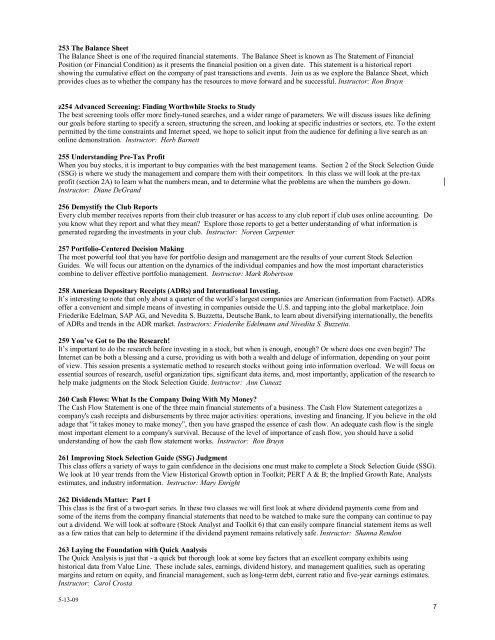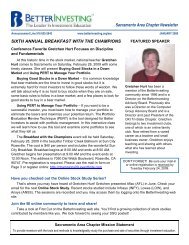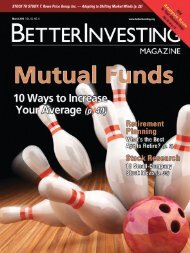Class Descriptions 2009 - BetterInvesting
Class Descriptions 2009 - BetterInvesting
Class Descriptions 2009 - BetterInvesting
Create successful ePaper yourself
Turn your PDF publications into a flip-book with our unique Google optimized e-Paper software.
253 The Balance Sheet<br />
The Balance Sheet is one of the required financial statements. The Balance Sheet is known as The Statement of Financial<br />
Position (or Financial Condition) as it presents the financial position on a given date. This statement is a historical report<br />
showing the cumulative effect on the company of past transactions and events. Join us as we explore the Balance Sheet, which<br />
provides clues as to whether the company has the resources to move forward and be successful. Instructor: Ron Bruyn<br />
z254 Advanced Screening: Finding Worthwhile Stocks to Study<br />
The best screening tools offer more finely-tuned searches, and a wider range of parameters. We will discuss issues like defining<br />
our goals before starting to specify a screen, structuring the screen, and looking at specific industries or sectors, etc. To the extent<br />
permitted by the time constraints and Internet speed, we hope to solicit input from the audience for defining a live search as an<br />
online demonstration. Instructor: Herb Barnett<br />
255 Understanding Pre-Tax Profit<br />
When you buy stocks, it is important to buy companies with the best management teams. Section 2 of the Stock Selection Guide<br />
(SSG) is where we study the management and compare them with their competitors. In this class we will look at the pre-tax<br />
profit (section 2A) to learn what the numbers mean, and to determine what the problems are when the numbers go down.<br />
Instructor: Diane DeGrand<br />
256 Demystify the Club Reports<br />
Every club member receives reports from their club treasurer or has access to any club report if club uses online accounting. Do<br />
you know what they report and what they mean Explore those reports to get a better understanding of what information is<br />
generated regarding the investments in your club. Instructor: Noreen Carpenter<br />
257 Portfolio-Centered Decision Making<br />
The most powerful tool that you have for portfolio design and management are the results of your current Stock Selection<br />
Guides. We will focus our attention on the dynamics of the individual companies and how the most important characteristics<br />
combine to deliver effective portfolio management. Instructor: Mark Robertson<br />
258 American Depositary Receipts (ADRs) and International Investing.<br />
It’s interesting to note that only about a quarter of the world’s largest companies are American (information from Factset). ADRs<br />
offer a convenient and simple means of investing in companies outside the U.S. and tapping into the global marketplace. Join<br />
Friederike Edelman, SAP AG, and Nevedita S. Buzzetta, Deutsche Bank, to learn about diversifying internationally, the benefits<br />
of ADRs and trends in the ADR market. Instructors: Friederike Edelmann and Nivedita S. Buzzetta.<br />
259 You’ve Got to Do the Research!<br />
It’s important to do the research before investing in a stock, but when is enough, enough Or where does one even begin The<br />
Internet can be both a blessing and a curse, providing us with both a wealth and deluge of information, depending on your point<br />
of view. This session presents a systematic method to research stocks without going into information overload. We will focus on<br />
essential sources of research, useful organization tips, significant data items, and, most importantly, application of the research to<br />
help make judgments on the Stock Selection Guide. Instructor: Ann Cuneaz<br />
260 Cash Flows: What Is the Company Doing With My Money<br />
The Cash Flow Statement is one of the three main financial statements of a business. The Cash Flow Statement categorizes a<br />
company's cash receipts and disbursements by three major activities: operations, investing and financing. If you believe in the old<br />
adage that "it takes money to make money”, then you have grasped the essence of cash flow. An adequate cash flow is the single<br />
most important element to a company's survival. Because of the level of importance of cash flow, you should have a solid<br />
understanding of how the cash flow statement works. Instructor: Ron Bruyn<br />
261 Improving Stock Selection Guide (SSG) Judgment<br />
This class offers a variety of ways to gain confidence in the decisions one must make to complete a Stock Selection Guide (SSG).<br />
We look at 10 year trends from the View Historical Growth option in Toolkit; PERT A & B; the Implied Growth Rate, Analysts<br />
estimates, and industry information. Instructor: Mary Enright<br />
262 Dividends Matter: Part I<br />
This class is the first of a two-part series. In these two classes we will first look at where dividend payments come from and<br />
some of the items from the company financial statements that need to be watched to make sure the company can continue to pay<br />
out a dividend. We will look at software (Stock Analyst and Toolkit 6) that can easily compare financial statement items as well<br />
as a few ratios that can help to determine if the dividend payment remains relatively safe. Instructor: Shanna Rendon<br />
263 Laying the Foundation with Quick Analysis<br />
The Quick Analysis is just that - a quick but thorough look at some key factors that an excellent company exhibits using<br />
historical data from Value Line. These include sales, earnings, dividend history, and management qualities, such as operating<br />
margins and return on equity, and financial management, such as long-term debt, current ratio and five-year earnings estimates.<br />
Instructor: Carol Crosta<br />
5-13-09<br />
7





